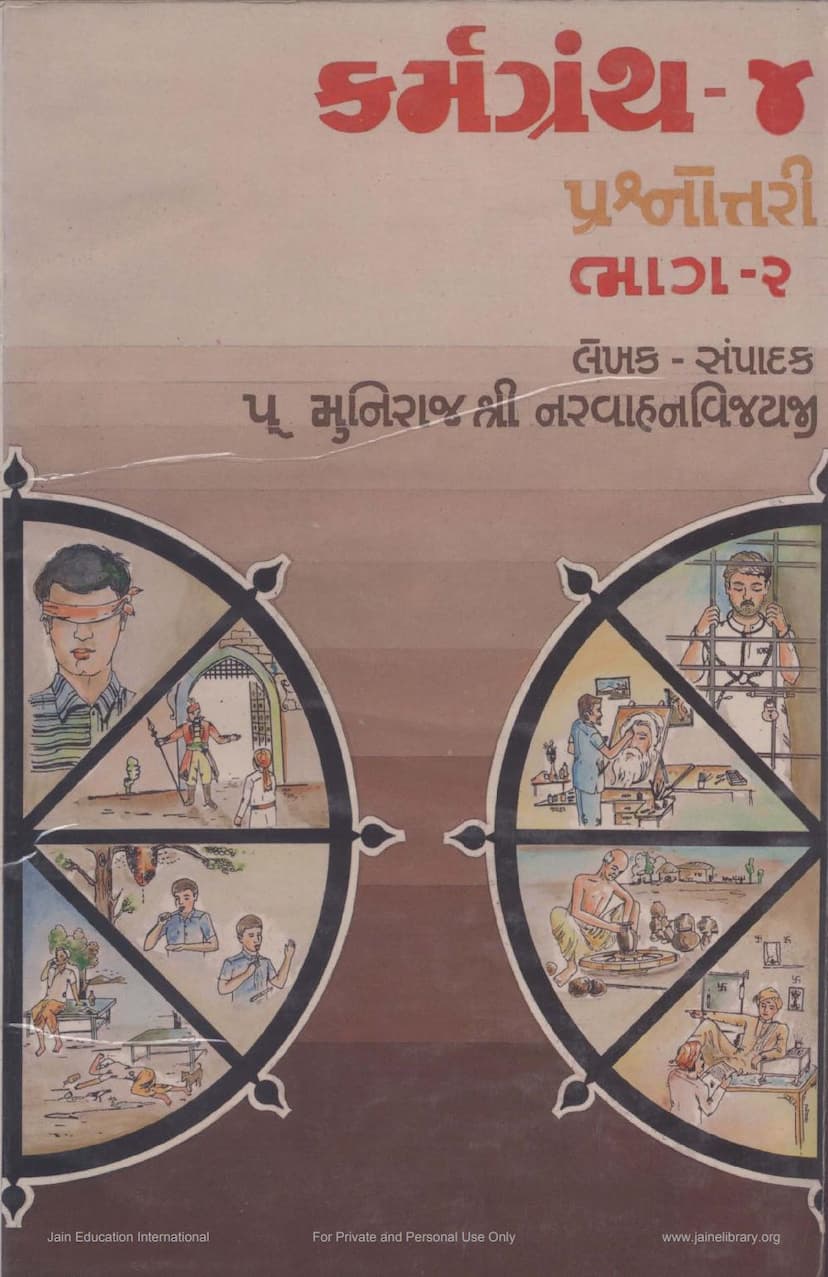Karmgranth 04 By 02 Prashnottari
Added to library: September 2, 2025

Summary
This is a summary of Karmgranth Vol. 4, Prashnottari (Part 2) by Muni Shri Narvahanvijay, published by Fulabhai Ranchhodbhai Parivar.
This book is the second part of the "Prashnottari Granthamala" (Question-Answer Series) focusing on Jain Karma theory. It aims to explain the complex concepts of karma in a question-and-answer format, making them accessible to the general Jain community.
Here's a breakdown of the key aspects and content covered in the book:
Core Theme:
- Understanding Karma through Questions: The book systematically breaks down the intricate science of karma into a series of questions and answers, covering various aspects of karmic bondage, its causes, effects, and eventual eradication.
Key Concepts Covered:
The book delves into a wide range of topics related to Jain philosophy and karma, including:
- The Nature of Karma: It explains the fundamental principles of karma, how it binds the soul, and the distinct roles of "Karmasatta" (power of karma) and "Dharmasatta" (power of Dharma/righteousness). It highlights the superiority of Jain karma science, calling it unfathomable and mathematically precise compared to worldly sciences and computers.
- Causes of Karmic Bondage: The text identifies the five primary causes of karmic bondage as mentioned in scriptures: Mithyatva (false belief), Avirati (non-restraint), Kashay (passions), Pramad (neglect), and Yoga (activity of mind, speech, and body). It elaborates on how overcoming these leads to spiritual progress.
- The Soul's Journey: The book describes the soul's journey from the lowest states (Nigod) to liberation (Moksha), emphasizing the role of good karma in supporting this progression and negative karma in hindering it.
- The Power of Dharma: It stresses that only Dharma has the strength to remove karma from the soul. It uses the analogy of karma sitting on the chest of Dharma, only to be dislodged when Dharma asserts itself.
- The Soul vs. Karma: The text explains that the soul, being conscious, is ultimately stronger than the inert karma. It illustrates this by stating that karma needs countless soldiers (karmic particles) to control each particle of the soul, highlighting the soul's inherent potential.
- Stages of Spiritual Progress (Gun Sthanak): The book extensively discusses the various "Gun Sthanak" (stages of spiritual development), detailing the presence or absence of different karmas, yogas, senses, knowledge types, and even the number of souls in each stage.
- Margaṇā (Lines of Inquiry): A significant portion of the book is dedicated to the concept of "Margaṇā," which are categories or lines of inquiry used to analyze the presence or absence of various karmic states, karmic tendencies, types of knowledge, the soul's condition, and so on, across different species, senses, activities, and states of consciousness. The book systematically lists how many Margaṇā are applicable to each of the 62 categories. This is a major focus of this specific volume.
- Types of Knowledge and Conduct: It details the different types of knowledge (Jñāna) and ignorance (Ajñāna), as well as the various stages of conduct (Caritra), and how they relate to different spiritual stages.
- The Five Bhavas (States of Existence): The book explains the five fundamental states of the soul: Upasham (suppression), Kshāyika (destruction), Kshayopashamika (destruction-suppression), Audayika (fruitional), and Pārināmika (transformational), and their respective sub-categories and appearances in different Gun Sthanaks.
- Numerical Classifications: A considerable part of the book involves extensive numerical classifications. It details the number of relevant Margaṇā for each category, the number of Bhavas in different Gun Sthanaks, the number of karmic bondage causes (Bandha Hetu) in each Gun Sthanak, and the number of applicable Bhavas for various Margaṇā. This structured, quantitative approach is characteristic of detailed scholastic Jain literature.
- Support and Dedication: The book acknowledges the support received from various individuals and institutions, including the publisher family, and spiritual gurus, emphasizing the collaborative effort in disseminating this knowledge. It also includes a "Donors List."
- Errata: A detailed errata section is provided to correct any printing errors in the book, reflecting a commitment to accuracy.
Author and Editorial Intent:
- Muni Shri Narvahanvijayji: The author is a scholar and expert in karma literature, following in the footsteps of his gurus, Acharya Shri Vijay Ramchandra Surishwarji Maharaj and other revered monks.
- Accessibility: The primary goal of the "Prashnottari Granthamala" is to make profound Jain philosophical concepts accessible to the common seeker of knowledge.
- Spiritual Growth: The ultimate aim is to help readers understand the mechanics of karma to facilitate their spiritual liberation from karmic bondage and progress towards the state of Paramatma (Supreme Soul).
Target Audience:
This book is intended for Jain scholars, students of Jain philosophy, and anyone interested in a detailed, systematic, and question-answer-based study of Jain karma theory. The extensive use of numerical data and specific terminology suggests a readership that is already familiar with some fundamental Jain concepts.